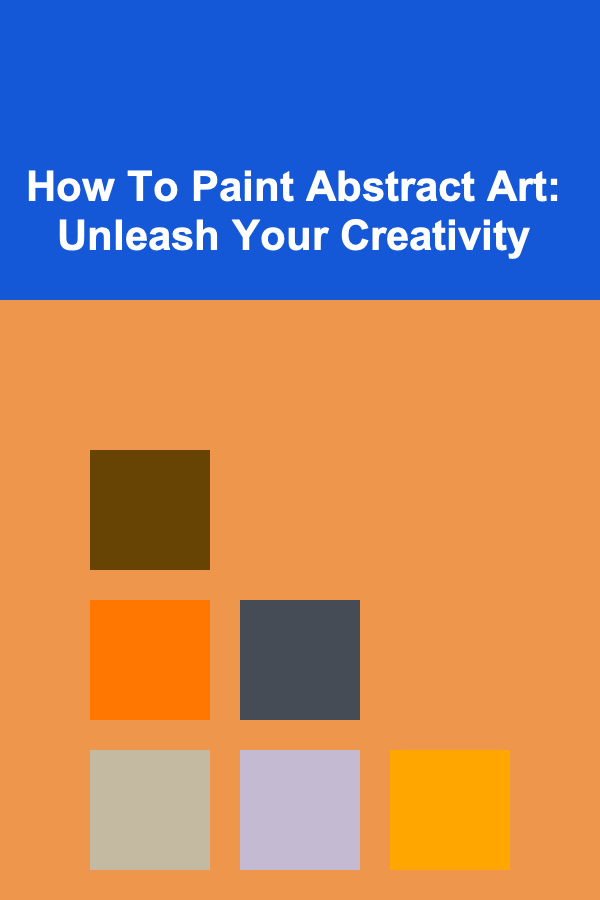
How To Paint Abstract Art: Unleash Your Creativity
ebook include PDF & Audio bundle (Micro Guide)
$12.99$7.99
Limited Time Offer! Order within the next:

Abstract art, often perceived as enigmatic and difficult to understand, is fundamentally about expressing emotions, ideas, and experiences through non-representational forms. It's a realm where the traditional rules of perspective and realism are discarded, allowing the artist to explore the pure essence of color, line, shape, texture, and composition. This guide aims to demystify the process of creating abstract art, providing you with a roadmap to unleash your inner creativity and embark on a fulfilling artistic journey.
At its core, abstract art is an exploration of the subconscious and a dialogue with materials. It's about surrendering control and embracing the unexpected, allowing the painting to evolve organically. There's no right or wrong way to approach abstract art; the only constraint is your own willingness to experiment and discover your unique artistic voice.
Understanding Abstract Art: A Brief Overview
Before diving into the practical aspects of painting abstract art, it's beneficial to have a basic understanding of its history and key concepts. Abstract art emerged as a significant movement in the early 20th century, challenging the established norms of representational art. Artists like Wassily Kandinsky, Piet Mondrian, and Kazimir Malevich pioneered various forms of abstraction, each with its distinct philosophy and aesthetic.
Key Movements in Abstract Art:
- Abstract Expressionism: Characterized by gestural brushstrokes, large canvases, and an emphasis on the artist's emotions and subconscious. Prominent figures include Jackson Pollock, Mark Rothko, and Willem de Kooning.
- Cubism: Deconstructing objects into geometric forms and presenting them from multiple viewpoints simultaneously. Pablo Picasso and Georges Braque were the leading figures of this movement.
- Suprematism: Focusing on basic geometric forms, such as squares and circles, to represent pure artistic feeling. Kazimir Malevich was the founder of Suprematism.
- De Stijl: Emphasizing geometric abstraction and primary colors (red, blue, yellow) to achieve a sense of harmony and balance. Piet Mondrian was a key figure in De Stijl.
- Color Field Painting: Large-scale canvases featuring fields of solid color, often intended to evoke emotional or spiritual responses. Mark Rothko and Barnett Newman were prominent Color Field painters.
While these movements offer a framework for understanding abstract art, it's important to remember that abstract art is constantly evolving. Contemporary abstract artists continue to push the boundaries of the genre, incorporating new materials, techniques, and concepts into their work.
Gathering Your Materials: Setting the Stage for Creativity
The choice of materials can significantly impact the outcome of your abstract painting. Experiment with different mediums and tools to discover what resonates with your artistic vision. Here's a breakdown of essential materials:
1. Surfaces:
- Canvas: A classic choice for painting, offering a textured surface that can hold paint well. Available in various sizes and grades. Consider primed canvas for immediate use.
- Wood Panels: Provides a rigid and stable surface, ideal for mixed media or techniques that involve heavy layering.
- Paper: Suitable for experimenting with watercolors, acrylics, or inks. Choose heavyweight paper to prevent buckling.
- Alternative Surfaces: Explore unconventional surfaces like metal sheets, fabric, or even found objects for unique textures and effects.
2. Paints:
- Acrylics: Fast-drying, versatile, and water-based, acrylics are a popular choice for abstract art. They can be thinned with water or acrylic mediums and can be layered without cracking.
- Oils: Offer rich colors, a smooth texture, and a longer drying time, allowing for blending and manipulation. Oil paints require solvents for cleaning and thinning.
- Watercolors: Transparent and fluid, watercolors are ideal for creating washes and delicate effects. They're best suited for paper surfaces.
- Inks: Highly pigmented and versatile, inks can be used for drawing, washes, and creating intricate patterns.
3. Brushes and Tools:
- Brushes: A variety of brush sizes and shapes (round, flat, filbert, angled) are essential for creating different marks and textures. Experiment with both synthetic and natural bristle brushes.
- Palette Knives: Used for applying paint in thick layers, creating impasto effects, and scraping away paint.
- Sponges: Can be used to create textured surfaces and apply paint in unconventional ways.
- Rags and Cloths: Essential for cleaning brushes, blending paint, and creating textures.
- Other Tools: Explore using household items like combs, forks, spatulas, or even your fingers to create unique marks and textures.
4. Mediums and Additives:
- Acrylic Mediums: Extend the drying time of acrylics, increase transparency, or add texture. Examples include gel mediums, glazing mediums, and retarders.
- Oil Painting Mediums: Thin oil paints, increase gloss, or speed up drying time. Linseed oil, turpentine, and mineral spirits are common oil painting mediums.
- Gesso: A primer applied to the surface to create a smooth and absorbent surface for paint.
- Varnish: A protective coating applied to the finished painting to protect it from dust, dirt, and UV damage.
5. Palette and Support:
- Palette: A surface for mixing paints. Disposable palettes, wet palettes (for acrylics), and traditional wooden palettes are available.
- Easel: A support for holding the canvas or painting surface. Adjustable easels provide flexibility in terms of height and angle.
Don't feel obligated to purchase expensive materials initially. Start with a basic set of paints, brushes, and a few canvases, and gradually expand your collection as you experiment and discover your preferences.
Finding Your Inspiration: Fueling the Creative Fire
Inspiration for abstract art can come from anywhere -- nature, music, emotions, memories, or even other works of art. The key is to cultivate a sense of openness and curiosity, allowing yourself to be receptive to the world around you.
1. Nature:
Observe the colors, patterns, and textures found in nature. The way sunlight filters through leaves, the intricate patterns of a seashell, or the vastness of the ocean can all serve as sources of inspiration. Focus not on replicating what you see literally, but on capturing the feeling and essence of the natural world.
2. Music:
Listen to different genres of music and translate the sounds and rhythms into visual forms. Consider the tempo, melody, and harmony of the music and how they evoke different emotions. Experiment with colors and brushstrokes that reflect the mood and energy of the music.
3. Emotions:
Abstract art provides a powerful outlet for expressing emotions. Explore your feelings through color, line, and texture. Consider what colors represent certain emotions for you (e.g., blue for sadness, red for anger, yellow for joy) and use them to create a visual representation of your inner state.
4. Memories:
Recall vivid memories and translate them into abstract compositions. Focus on the sensory details of the memory -- the colors, sounds, smells, and textures -- and use them to create a non-representational artwork that captures the essence of the experience.
5. Other Art:
Study the works of abstract artists and analyze their techniques, compositions, and use of color. Don't try to copy their style, but rather use their work as a starting point for your own exploration. Visit museums and galleries, browse art books, and explore online art resources.
6. The Subconscious:
Embrace the power of the subconscious mind. Engage in free association exercises, automatic drawing, or journaling to tap into your inner creativity. Allow your hand to move freely across the canvas without consciously controlling the outcome. This can lead to surprising and unexpected results.
Keep a sketchbook or journal to record your ideas, sketches, and inspirations. Collect images, colors, and textures that appeal to you. The more you immerse yourself in the world of art and creativity, the more inspiration you'll find.
Techniques and Approaches: Exploring the Possibilities
Abstract art encompasses a wide range of techniques and approaches. Experiment with different methods to discover what resonates with your personal style and creative goals.
1. Layering:
Building up layers of paint, glazes, and textures can create depth and complexity in your abstract paintings. Allow each layer to dry before applying the next, or work wet-on-wet for blended effects. Experiment with different levels of transparency and opacity in each layer.
2. Color Mixing and Harmony:
Understanding color theory is crucial for creating visually appealing abstract art. Experiment with different color combinations, such as complementary colors, analogous colors, and monochromatic schemes. Consider the emotional impact of different colors and how they interact with each other.
3. Mark-Making:
The marks you make on the canvas can convey different emotions and energies. Experiment with different brushstrokes, lines, and textures. Use a variety of tools, such as brushes, palette knives, sponges, and rags, to create unique marks. Consider the direction, pressure, and speed of your mark-making.
4. Texture:
Adding texture to your abstract paintings can create visual interest and tactile appeal. Experiment with different techniques, such as impasto (thickly applied paint), collage (adding found objects to the surface), and scumbling (dry brushing). Use texture mediums to create raised surfaces or add gritty textures to your paint.
5. Composition:
The arrangement of elements within the painting is crucial for creating a balanced and harmonious composition. Consider the placement of shapes, lines, and colors. Experiment with different compositional techniques, such as the rule of thirds, the golden ratio, and the use of positive and negative space.
6. Drip Painting:
Made famous by Jackson Pollock, drip painting involves dripping or splattering paint onto the canvas. This technique is often used to create energetic and spontaneous abstract paintings. Experiment with different paint consistencies and pouring techniques.
7. Pouring Techniques:
Pouring paint directly onto the canvas and manipulating it by tilting, rotating, or dragging can create fluid and organic patterns. This technique often involves using thinned acrylic paints and pouring mediums.
8. Collage and Mixed Media:
Combining different materials, such as paper, fabric, found objects, and paint, can add depth, texture, and visual interest to your abstract paintings. Experiment with different adhesives and layering techniques to create unique mixed media compositions.
9. Negative Space:
Paying attention to the areas of the canvas that are left unpainted or minimally painted can be just as important as the areas that are covered in paint. Use negative space to create balance, contrast, and visual breathing room in your compositions.
10. Exploring Different Surfaces:
Branch out from traditional canvas. Try painting on wood panels, metal, glass, or even unconventional surfaces like cardboard or fabric. Each surface will react differently to the paint and offer unique textural possibilities.
Remember, there are no rules in abstract art. The key is to experiment, explore, and discover what works best for you. Don't be afraid to break the rules and try new things. The more you experiment, the more you'll develop your own unique style and techniques.
The Creative Process: From Inspiration to Completion
The creative process in abstract art is often non-linear and intuitive. It involves a continuous interplay between intention and spontaneity, planning and improvisation. Here's a general framework to guide you through the process:
1. Initial Exploration:
Start by gathering your materials and preparing your surface. Take some time to meditate on your inspiration or intention for the painting. You can also create some quick sketches or color studies to explore different ideas.
2. Laying Down the Foundation:
Begin by applying a base layer of paint or gesso to the surface. This layer can be a solid color, a textured wash, or a more complex underpainting. Don't overthink this stage; simply let your intuition guide you.
3. Adding Layers and Textures:
Start building up layers of paint, textures, and marks. Experiment with different techniques and tools. Allow the painting to evolve organically, responding to the emerging forms and colors. Don't be afraid to make mistakes; they can often lead to unexpected discoveries.
4. Refining the Composition:
As the painting progresses, step back and assess the composition. Pay attention to the balance, harmony, and visual flow of the elements. Make adjustments as needed to create a more compelling and unified image.
5. Adding Details and Finishing Touches:
In the final stages of the painting, add details and finishing touches. This may involve refining certain areas, adding highlights, or creating contrast. Be mindful of not overworking the painting. Sometimes, less is more.
6. Stepping Back and Reflecting:
Once you feel the painting is complete, step back and take some time to reflect on it. What emotions does it evoke? What story does it tell? Are you satisfied with the final result? If not, you can always make further adjustments or even start a new painting.
Throughout the creative process, remember to be patient, persistent, and open to new possibilities. Embrace the unexpected and learn from your mistakes. The more you practice, the more confident and skilled you'll become as an abstract artist.
Tips for Overcoming Creative Blocks:
- Change Your Environment: Move to a different room, go outside, or visit a museum.
- Try a New Technique: Experiment with a different medium, tool, or approach.
- Take a Break: Step away from the painting and do something completely unrelated.
- Look at Other Art: Find inspiration in the work of other artists.
- Engage in Free Writing: Write down your thoughts and feelings without editing yourself.
- Just Start: Sometimes, the best way to overcome a creative block is to simply start painting, even if you don't have a clear idea in mind.
Critiquing Your Own Work: Developing a Critical Eye
Developing the ability to critique your own work is essential for growth as an abstract artist. It allows you to identify strengths and weaknesses, learn from your mistakes, and refine your artistic vision. Here are some tips for critiquing your own work:
1. Step Back and Observe:
Take some time to distance yourself from the painting, both physically and mentally. Step back several feet and observe the painting from different angles. Try viewing the painting in different lighting conditions.
2. Consider the Composition:
Analyze the composition of the painting. Is it balanced and harmonious? Are there any areas that feel unbalanced or distracting? How does the eye move across the canvas?
3. Evaluate the Use of Color:
Assess the use of color in the painting. Are the colors harmonious or dissonant? Do they create a desired mood or atmosphere? Are there any color combinations that don't work well?
4. Examine the Mark-Making and Texture:
Evaluate the marks and textures in the painting. Are they varied and interesting? Do they contribute to the overall composition? Are there any areas that feel overworked or repetitive?
5. Identify Strengths and Weaknesses:
Make a list of the strengths and weaknesses of the painting. What aspects of the painting are successful? What areas could be improved?
6. Ask for Feedback:
Share your work with other artists or art professionals and ask for their feedback. Be open to constructive criticism and use it to improve your future work.
7. Keep a Record of Your Progress:
Document your work by taking photographs or videos. This will allow you to track your progress over time and identify patterns in your artistic development.
8. Don't Be Too Harsh:
Be kind to yourself and avoid being overly critical. Remember that every painting is a learning experience, and even "failures" can provide valuable insights.
Critiquing your own work is an ongoing process. The more you practice, the more skilled you'll become at identifying areas for improvement and refining your artistic vision.
Embracing Experimentation and Letting Go of Control
The essence of abstract art lies in its freedom from representation and its embrace of experimentation. The most important aspect of learning to paint abstractly is letting go of the need to control the outcome. Allow the process to unfold organically, trusting your intuition and embracing the unexpected.
1. Break the Rules:
Forget everything you think you know about art. There are no rules in abstract art. Experiment with different techniques, materials, and approaches. Don't be afraid to break the mold and create something completely original.
2. Trust Your Intuition:
Let your intuition guide your artistic decisions. Don't overthink the process; simply allow yourself to be present in the moment and respond to the emerging forms and colors.
3. Embrace the Unexpected:
Be open to the unexpected. Mistakes and accidents can often lead to new discoveries and innovative techniques. Don't be afraid to experiment and take risks.
4. Don't Be Afraid to Fail:
Failure is an inevitable part of the creative process. Don't be discouraged by "bad" paintings. Learn from your mistakes and keep experimenting.
5. Find Your Own Voice:
Ultimately, the goal of abstract art is to express your unique artistic vision. Don't try to copy the style of other artists. Find your own voice and create art that is authentic and meaningful to you.
Abstract art is a journey of self-discovery. Embrace the process, enjoy the ride, and allow your creativity to flourish.
Conclusion: The Ongoing Journey of Artistic Exploration
Painting abstract art is an ongoing journey of exploration, experimentation, and self-discovery. There's no destination, only the continuous process of learning, growing, and expressing your unique artistic vision. Embrace the challenges, celebrate the successes, and never stop exploring the boundless possibilities of abstract art.
By understanding the fundamentals of abstract art, gathering the right materials, finding your inspiration, experimenting with different techniques, critiquing your own work, and embracing experimentation, you can unlock your creative potential and embark on a fulfilling artistic journey. So, grab your brushes, unleash your imagination, and start painting!

How to Invest in Bonds for Steady Income
Read More
How to Save on Home Cleaning Supplies and Services
Read More
How to Set Up a Family Puzzle Challenge
Read More
How to Use Acoustic Curtains to Improve Sound Quality in Your Home
Read More
How to Use Labels to Help Organize Family Room Items
Read More
How To Explore CAR T-Cell Therapy for Blood Cancers
Read MoreOther Products

How to Invest in Bonds for Steady Income
Read More
How to Save on Home Cleaning Supplies and Services
Read More
How to Set Up a Family Puzzle Challenge
Read More
How to Use Acoustic Curtains to Improve Sound Quality in Your Home
Read More
How to Use Labels to Help Organize Family Room Items
Read More